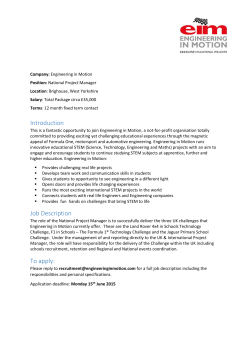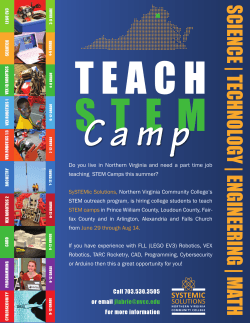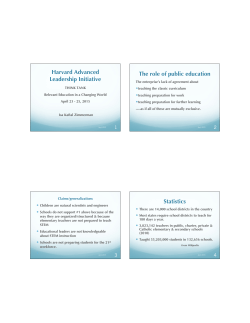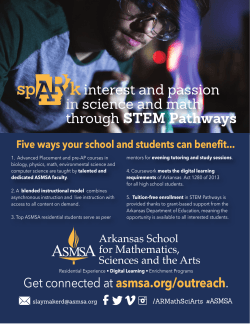
Force in STEM for Elementary Teachers
Elementary STEM Endorsement Force in STEM for Elementary Teachers Utah State Office of Education Elementary STEM Endorsement Course Framework Force in STEM for Elementary Teachers Course Description: This course provides teachers with a deep and useful understanding of force and the nature of how students use concepts of force to make sense of phenomena across life, earth, and physical science. This understanding enhances teacher insights into: 1) how force, matter and energy interact, 2) the relationship of force to energy and interactions within fields, and 3) pedagogical content knowledge around teaching and learning about force. The course provides teachers with knowledge of how concepts of force may be used by students with the Crosscutting Concepts, and Engineering and Science practices. Course Objectives: At the conclusion of this course, educators will: ● Understand the role of force in systems in the natural and material world and relate it to STEM instruction in elementary classrooms including: ○ Gravity and it’s role in the solar system ○ Forces that impact Earth’s materials and systems ○ The relationship between force, mass, acceleration, inertia, and energy transfer Understand and be able to apply the cross-cutting concept of force to teach ● disciplinary core ideas. ● Develop the skills and dispositions to be a teacher leader in STEM, model instruction, plan with colleagues, complete presentations for local and statewide efforts, etc. ● Use student achievement data to design authentic, innovative, problem-based learning experiences. ○ Use formative assessment to inform instruction. ● Explore uses of appropriate assessment and technological tools to enhance teaching, learning, student achievement, and college career readiness. ○ Possess the ability to help learners learn “with” technology vs. “from” ○ Work with students to understand that they are both producers and consumers of technology. Explore and implement innovative, research-based, engaging curriculum, especially ● around the Utah Core academic standards and college and career readiness, geared towards increasing student achievement. ○ Apply the disciplinary core ideas when planning lessons and teaching. ○ Use cross-cutting concepts when planning lessons and teaching. ○ Implement scientific practices into lesson planning and teaching. ● STEM endorsed teachers will be confident users and implementers of technology. 10/15 1 Elementary STEM Endorsement Force in STEM for Elementary Teachers Course Construction Recommendation The goal of this course is to present a variety of non-standard STEM scenarios which will challenge participants to think, explore, communicate, and present solutions. It could be organized many ways, but should establish the teacher more as a mentor than a lecturer. Participants should feel safe following whatever thinking path they launch and allowed to self-correct without intervention. Scenarios should progress in difficulty as the course progresses to ensure participants feel confident in their abilities at the start, grow in tenacity and ability, and feel challenged. It is ideal if scenarios toward the end of the course require multiple strategies and solutions. The course should model quality instructional strategies including multiple opportunities to engage students in science investigations, field experiences, and lab activities. Course Topics: Please see Addendum A for a more detailed outline of topics for science content that would support the main ideas highlighted below. Main Idea #1 - Force in Earth and Space Science Force plays a critical role in determining spatial patterns, movement and organization of the solar system and universe. Understanding the relationship between gravity, mass and motion of planetary objects provides the foundation for explaining and predicting eclipses, lunar phases and seasons. Forces drive the movement of tectonic plates and impact the formation of Earth materials and landforms. The forces of water, wind, ice, gravity, and biodegradation are surface processes that modify tectonic features and contribute to the formation of the rock record. Main Idea #2 - Force in Life Sciences The history of life is inextricably linked to the history of the earth. Where, how and when life appear and diversified is dependent upon the conditions that were created by the interactions of Earth’s systems. Main Idea #3 - Force in Physical Science The relationship between force and mass is fundamental to explaining and predicting motion and energy transfer. Pedagogy Focus of Course The purpose of this course is to ensure that course participants apply the pedagogical content knowledge consistent with the current research in teaching and learning. Course participants must know how to create environments to ensure content knowledge and conceptual understandings inherent in the content. Course participants should integrate the content with a variety of pedagogical concepts and strategies into the course. This integration should be modeled throughout the course to create a student-centered 10/15 2 Elementary STEM Endorsement Force in STEM for Elementary Teachers learning environment in which elementary students plan and carry out investigations, engineer solutions to problems, and construct evidence-based explanations of realworld phenomena. The course participants are expected to model quality instructional strategies including multiple opportunities to engage students in science investigations, field experiences, and lab activities. Knowledge of STEM for course participant: Course participants learn the skills and dispositions to employ content knowledge, skills, and cross-cutting concepts to engage students in instruction that clarifies misconceptions about force in STEM. Course participants utilize knowledge of cognition, child development, and learning theory to enhance instruction. Including: 1. Understandings of science content and process knowledge and skills 2. Abilities to think critically and solve simple to complex problems 3. Capabilities of designing scientific experiments, analyzing data, and drawing conclusions 4. Capacities to see and articulate relationships between science topics and real-world issues and concerns 5. Skills using mathematics as a tool for science learning (From NSTA position statement on assessment) Effective STEM teaching practices: ● Ability to Ask Scientific Questions and Define Problems ● Ability to Plan and Carry Out Investigations ● Ability to Analyze, Interpret Data, and Make Predictions ● Ability to Develop and Use Models ● Ability to Construct Explanations and Design Solutions ● Ability to Engage in Argument from Evidence ● Ability to Use Mathematical and Computational Thinking ● Ability to Obtain, Evaluate and Communicate Information Knowledge of STEM curriculum and assessment: ● Know common developmental paths (learning trajectories) related to foundational STEM topics; understand these developmental paths, and use them to sequence activities to build learning environments that are developmentally appropriate and effective. ● Select, use, adapt and determine the suitability of curricula and teaching materials (e.g., textbooks, technology, manipulatives) for particular learning goals. ● Be cognizant of a formative assessment cycle (administering a formative assessment task, analyzing student work from the task, using that analysis to enhance teacher knowledge, and designing and teaching re engagement lessons) and resources. 10/15 3 Elementary STEM Endorsement Force in STEM for Elementary Teachers ● Provide appropriate interpretations of assessment results, and communicate results (in context) to specific individuals and groups (e.g., students, parents, caregivers, colleagues, administrators, policy makers, community members). Possible Assignments: ● Increase teacher focus on students’ ways to apply knowledge of force. ○ Participants select readings or viewings that provide evidence of the effectiveness of problem or problem-based learning that they will present to other class members, using various tools of technology. ○ Ask participants to bring examples of classroom lessons that incorporate STEM practices and technological tools for discussion. ● Engage teachers in discussion about three principles of force: 1) inertia, 2) force and mass, 3) the principle of action-reaction and how to teach it ● Use cross cutting concepts and science and engineering practices for understanding the concept of force in classroom activities. ○ Ask participants to bring examples of classroom lessons that incorporate STEM practices and technological tools for discussion. ○ Model problem-based learning experiences that incorporate meaningful integration of technologies. Use class time to practice these skills as needed, based on assessment of student ● achievement. Explore uses of appropriate assessment and technological tools to enhance STEM. ● Pine wood Derby ● stick pulls ● Problem-based learning activities that are also shared and discussed in class ● erosion prevention ● centrifugal force ● egg drop ● parachutes ● catapults ● balloon rockets (straw on a balloon, string through the straw) ● paper airplanes ● observations of forces in natural phenomenon Suggested Resources: ● google teacher guide force http://smile.cosi.org/fmk-2tg.pdf ● Civil Air Patrol www.heaviator2@msn.com ● http://departments.jordandistrict.org/curriculum/science/elementary/ ● http://www.nea.org/tools/lessons/stem-resources.html STEM Resources ● www.coe.edu/k12_events ( University of Utah Engineering ) ● http://www.nasa.gov/audience/foreducators NASA 10/15 4 Elementary STEM Endorsement Force in STEM for Elementary Teachers ● http://www.steveplanger.com ● http://www.pbs.org/teachers/stem/ ● http://www.looseinthelabscience.com/ 10/15 5 Elementary STEM Endorsement Force in STEM for Elementary Teachers Addendum A Main Idea #1 - Forces and Earth and Space Science ● (ESS1.A) The Universe and its stars (K-2) Patterns of movement of the sun, the moon and stars as seen from Earth can be observed, described, and predicted. (3-5) Stars range greatly in size and distance from Earth and this can explain their relative brightness (6-8) The solar system contains many varied objects held together by gravity. Solar system models explain and predict eclipses, lunar phases, and seasons. ● (ESS1.B) Earth and the Solar System (K-2) Patterns of movement of the sun, the moon and stars as seen from Earth can be observed, described, and predicted. (3-5) The Earth’s orbit and rotation, and the orbit of the moon around the Earth cause observable patterns. (6-8) The solar system contains many varied objects held together by gravity. Solar system models explain and predict eclipses, lunar phases, and seasons. ● (ESS1.C) History of Planet Earth (K-2) Some events on Earth occur very quickly: others can occur very slowly (3-5) Certain features on Earth can be used to order events that have occurred in a landscape. (6-8) Rock strata and the fossil record can be used as evidence to organize the relative occurrence of major historical events in earth’s history. ● (ESS2.A) Earth Materials and Systems (K-2)Wind and water change the shape of the land. (3-5)Four major Earth systems interact. Rainfall helps to shape the land and affects the types of living things found in a region. Water, ice, wind, organisms, and gravity break rocks, soils, and sediments into smaller pieces and move them around. (6-8) Energy flows and matter cycles within and among Earth’s system, including the sun and Earth’s interior as primary energy sources. Plate tectonics is one result of these processes. ● (ESS2.B) Plate Tectonics and large-scale System Interactions (K-2)Maps show where things are located. One can map the shapes and kinds of land and water in any area. 10/15 6 Elementary STEM Endorsement Force in STEM for Elementary Teachers (3-5) Earth’s physical features occur in patterns, as do earthquakes and volcanoes. Maps can be used to locate features and determine patterns in those events. (6-8) Plate tectonics is the unifying theory that explains movements of rocks at Earth’s surface and geological history. Maps are used to display evidence of plate movement. ● (ESS3.B) Natural Hazards (K-2) In a region, some kinds of severe weather are more likely than others. Forecasts allow communities to prepared for severe weather. (3-5) A variety of hazards results from natural processes: humans cannot eliminate hazards but can reduce their impacts. (6-8) Mapping the history of natural hazards in a region and understanding related geological forces shapes the course of human history. Main Idea #2 - Forces and Physical Science ● (PS2.A) Forces and Motion (K-2) Pushes and pulls can have different strengths and directions, and can change the speed or direction of its motion or start and stop it. (3-5) The effect of unbalanced forces on an object results in a change of motion. Patterns of motion can be used to predict future motion. Some forces act through contact, some forces act even when objects are not in contact. The gravitational force of earth acting on an object near Earth’s surface pulls that object toward the planet’s center. (6-8) The role of the mass of an object must be qualitatively accounted for in any change of motion due to the application of a force ● (PS2.B) Types of Interactions (K-2) Pushes and pulls can have different strengths and directions, and can change the speed or direction of its motion or start or stop it. (3-5) The effect of unbalanced forces on an object results in a change of motion. Patterns of motion can be used to predict future motion. Some forces act through contact, some forces act even when objects are not incontact. The gravitational force of earth acting on an object near Earth’s surface pulls that object toward the planet’s center. (6-8) Forces that act at a distance involve fields that can be mapped by their strength and effects on an objects. ● (PS3. C) Relationship Between Energy and Forces (K-2) Bigger pushes and pulls cause bigger changes in an object’s motion or shape. (3-5)When objects collide, contact forces transfer energy so as to change the object’s motion. 10/15 7 Elementary STEM Endorsement Force in STEM for Elementary Teachers (6-8) When two objects interact, each one exerts a force on the other, and these forces can transfer energy between them. Main Idea #3 - Forces and Life Sciences ● (LS4.A) Evidence of common ancestry and diversity (K-2) N/A (3-5) Some living organisms resemble organisms that once lived on earth. Fossils provide evidence the types of organism and environments that existed long ago. (6-8) The fossil record document diversity, existent, extinction, and change of many life forms and their environments through Earth’s history. The fossil record and comparisons of anatomical similarities between organisms enables the inference of lines of evolutionary descent. ● (LS4.D) Biodiversity and humans (K-2) A range of different organisms lives in different places (3-5) Population of organisms live in a variety of habitats. Change in those habitats affects the organism living there. (6-8) Changes in biodiversity can influence humans’ resources and ecosystems services they rely on. 10/15 8
© Copyright 2025










